
Osiel Cárdenas Guillén is a Mexican drug lord and the former leader of the Gulf Cartel and Los Zetas. Originally a mechanic in Matamoros, Tamaulipas, he entered the cartel by killing Juan García Abrego's friend and competitor Salvador Gómez, after the former's arrest in 1996. As confrontations with rival groups heated up, Osiel Cárdenas sought and recruited over 30 deserters from the Grupo Aeromóvil de Fuerzas Especiales to form the cartel's armed wing. Los Zetas served as the hired private mercenary army of the Gulf Cartel.

Los Zetas is a Mexican criminal syndicate, known as one of the most dangerous of Mexico's drug cartels. They are known for engaging in brutally violent "shock and awe" tactics such as beheadings, torture, and indiscriminate murder. While primarily concerned with drug trafficking, the organization also runs profitable sex and gun rackets. Los Zetas also operate through protection rackets, assassinations, extortion, kidnappings and other illegal activities. The organization is based in Nuevo Laredo, Tamaulipas, directly across the border from Laredo, Texas. The origins of Los Zetas date back to the late 1990s, when commandos of the Mexican Army deserted their ranks and began working as the enforcement arm of the Gulf Cartel. In February 2010, Los Zetas broke away and formed their own criminal organization, rivalling the Gulf Cartel.

Jorge Eduardo Costilla Sánchez is a former Mexican drug lord and top leader of the criminal drug trafficking organization known as the Gulf Cartel. He was among Mexico's most-wanted drug lords, until his arrest in 2012.

Miguel Ángel Treviño Morales, commonly referred to by his alias Z-40, is a Mexican former drug lord and leader of the criminal organization known as Los Zetas. Considered a violent, resentful and dangerous criminal, he was one of Mexico's most-wanted drug lords until his arrest in July 2013.

Heriberto Lazcano Lazcano, commonly referred to by his aliases Z-3 and El Lazca, was a Mexican drug lord and the leader of Los Zetas drug cartel. He was one of the most-wanted Mexican drug lords.

Antonio Ezequiel Cárdenas Guillén, commonly referred to by his alias Tony Tormenta, was a Mexican drug lord and co-leader of the Gulf Cartel, a drug trafficking organization based in Tamaulipas. He headed the criminal group along with Jorge Eduardo Costilla Sánchez. Antonio was considered by Mexican security forces as one of Mexico's most-wanted men.
This is a list of Mexico's 37 most-wanted drug lords as published by Mexican federal authorities on 23 March 2009. According to a BBC Mundo Mexico report, the 37 drug lords "have jeopardized Mexico national security."
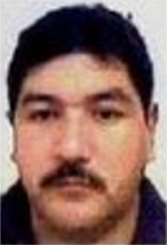
Iván Velázquez Caballero, also known by his alias El Talibán, is a Mexican convicted drug lord of the criminal group known as Los Zetas. The government of Mexico listed Velázquez Caballero in 2009 as one of its 37 most-wanted drug lords and was offering up to $30 million pesos, the equivalent of over $2.5 million USD, for information leading to his capture.

Samuel Flores Borrego was a Mexican drug lord and high-ranking lieutenant of the Gulf Cartel. He was a former state judicial policeman who protected the ex-leader of the Gulf cartel, Osiel Cárdenas Guillén. Upon his arrest, Flores Borrego became the right-hand man of Jorge Eduardo Costilla Sánchez, the former leader of the criminal organization.

Mario Armando Ramírez Treviño, commonly referred to by his aliases El Pelón and/or X-20, is a Mexican suspected drug lord and former leader of the Gulf Cartel, a drug trafficking organization.
The 2012 Nuevo Laredo massacres were a series of mass murder attacks between the allied Sinaloa Cartel and Gulf Cartel against Los Zetas in the border city of Nuevo Laredo, Tamaulipas, across the U.S.-Mexico border from Laredo, Texas. The drug-violence in Nuevo Laredo began back in 2003, when the city was controlled by the Gulf Cartel. Most media reports that write about the Mexican Drug War, however, point to 2006 as the start of the drug war. That year is a convenient historical marker because that's when Felipe Calderón took office and carried out an aggressive approach against the cartels. But authors like Ioan Grillo and Sylvia Longmire note that Mexico's drug war actually began at the end of Vicente Fox's administration in 2004, when the first major battle took place in Nuevo Laredo between the Sinaloa Cartel and Los Zetas, who at that time worked as the armed wing of the Gulf Cartel.
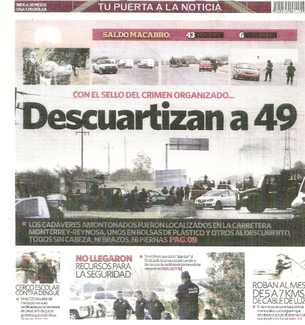
The Cadereyta Jiménez massacre occurred on the Fed 40 on 12–13 May 2012. Mexican officials stated that 49 people were decapitated and mutilated by members of Los Zetas drug cartel and dumped by a roadside near the city of Cadereyta Jiménez in northern Mexico. The Blog del Narco, a blog that documents events and people of the Mexican Drug War anonymously, reported that the actual (unofficial) death toll may be more than 68 people. The bodies were found in the town of San Juan in the municipality of Cadereyta Jiménez, Nuevo León at about 4 a.m. on a non-toll highway leading to Reynosa, Tamaulipas. The forty-three men and six women killed had their heads, feet, and hands cut off, making their identification difficult. Those killed also bore signs of torture and were stuffed in plastic bags. The arrested suspects have indicated that the victims were Gulf Cartel members, but the Mexican authorities have not ruled out the possibility that they were U.S.-bound migrants. Four days before this incident, 18 people were found decapitated and dismembered near Mexico's second largest city, Guadalajara.

José Treviño Morales is a Mexican former money launderer for Los Zetas, a Mexican criminal organization. He is the brother of the former Zetas leaders Omar Treviño Morales and Miguel Treviño Morales. In 2008, Treviño funded a horserace operation in Oklahoma with money he made through money laundering. Nonetheless, he was arrested by the FBI along with seven others in a horse-breeding ranch in Lexington, Oklahoma on 12 June 2012. He was found guilty of money laundering in May 2013, and was sentenced to 20 years in prison by a U.S. federal court in September of that same year.
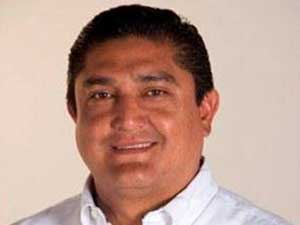
Édgar Morales Pérez was the mayor-elect of Matehuala, San Luis Potosí, Mexico, elected on July 1, 2012. He was a member of the Institutional Revolutionary Party (PRI) and the Ecologist Green Party of Mexico (PVEM), which are in a coalition in his municipality. The National Action Party (PAN) had ruled Matehuala for several years, and Morales Pérez was scheduled to take office in September 2012.

Efraín Teodoro Torres was a Mexican suspected drug lord and one of the founders of Los Zetas, a criminal organization formed by former soldiers of the Mexican Armed Forces. He joined the Mexican Army in mid-1991 but deserted after seven years of service. In 1998, Torres was recruited by the drug lord Osiel Cárdenas Guillén to join the ranks of the Gulf Cartel, a drug trafficking organization. The new group formed by ex-commandos came to be known as Los Zetas.

Miguel Villarreal was a U.S.-born Mexican suspected drug lord and high-ranking leader of the Gulf Cartel, a criminal group based in Tamaulipas. He was the crime boss of Reynosa, Tamaulipas. Nicknamed El Gringo in reference to his U.S. nationality, Villarreal was identified by authorities as a Gulf Cartel leader in 2010, when he allegedly commanded cells that fought Los Zetas drug cartel in northeastern Mexico. By 2011, he served as the regional kingpin in Miguel Alemán, Tamaulipas and ordered several kidnappings and killings in the South Texas border area from Mexico.
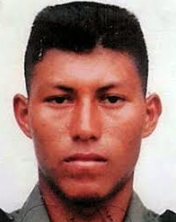
Raúl Hernández Barrón, also known by his alias Flanders 1, was a Mexican suspected drug lord and high-ranking member of Los Zetas, a criminal group based in Tamaulipas, Mexico. Hernández Barrón served in the Mexican Army from 1993 to 1999 as an infantry soldier. He then left and joined the Gulf Cartel under the kingpin Osiel Cárdenas Guillén, and became part of the first members of their newly formed paramilitary wing, Los Zetas. Like Hernández Barrón, most of the first members of Los Zetas were ex-military. Los Zetas was responsible for providing security services to Cárdenas Guillén and carrying out executions on the cartel's behalf. Hernández Barrón was also responsible for coordinating drug trafficking activities in Veracruz.
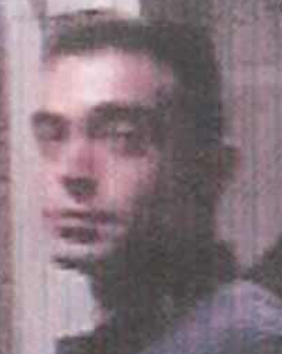
Jorge López Pérez, also known as El Chuta, is a Mexican suspected drug lord and high-ranking member of Los Zetas, a criminal group based in Tamaulipas, Mexico. López Pérez joined the Mexican Army in 1979. He specialized in martial arts, parachuting, explosives and guerrilla warfare tactics. In 1981, he deserted from the military and joined a cell of the Juárez Cartel, where he coordinated drug trafficking operations in Cancún. In the early 2000s, López Pérez left and worked as an independent trafficker before joining the Gulf Cartel. He became one of the first members of the cartel's newly formed paramilitary wing, Los Zetas. Like López Pérez, most of the first members of Los Zetas were ex-military. Wanted on drug trafficking charges, he is one of the last remaining fugitives from the early Zetas generation.

Omar Lorméndez Pitalúa is a Mexican suspected drug lord and high-ranking member of Los Zetas, a criminal group based in Tamaulipas, Mexico. He joined the Mexican Army in 1991 and deserted in 1999. He then joined the Gulf Cartel under kingpin Osiel Cárdenas Guillén, becoming one of the first members of its newly formed paramilitary wing, Los Zetas. Like Lorméndez Pitalúa, most of the original members of Los Zetas were ex-military. Los Zetas was responsible for providing security services to Cárdenas Guillén and carrying out executions on the cartel's behalf. In 2001, Lorméndez Pitalúa worked on assignments for Los Zetas and was responsible for ensuring that smugglers paid taxes to the Gulf Cartel and operated under their supervision in Matamoros.
Los Talibanes, known to a lesser extant as Los Nortes, are a Mexican criminal organization based in San Luis Potosí and Zacatecas. The name "Los Talibanes" is attributed to Iván Velázquez Caballero "El Talibán" or "El Z-50", who broke with Miguel Treviño Morales, "El Z-40", and allied himself with the Gulf Cartel to displace his former partner.















